A New Approach to Acoustics
Formula for Success
When preparing “Sound & Vibration 2.0: Design Guidelines for Health Care Facilities”—the companion document to the Facility Guidelines Institute’s (FGI) 2014 Guidelines for Design and Construction of Hospitals and Outpatient Facilities—acousticians developed a formula that provides a simplified predictive model for this approach. Basically, to “achieve confidential speech privacy the sum of the composite STC and the A-weighted background noise level shall be at least 75,” or STCc + dBA ≥ 75. Some refer to this formula as Speech Privacy Potential (SPP).2
While the need for speech privacy is obvious to organizations that consistently deal with sensitive information—such as hospitals—most people expect conversations occurring within closed rooms to remain private, making SPP broadly applicable. Even if an organization decides that it is more motivated by the need for a high-performance workplace than speech privacy, taking the steps required to lower speech intelligibility allows them to reap both rewards.
SPP considers the contribution of both room-to-room insulation and background sound level. While different organizations apply different metrics to these two elements, the STCc and dBA metrics outlined by the FGI Guidelines are particularly useful to the design process when the spectrum of background sound is also known in advance because it is to be provided by a correctly implemented sound masking system.
It is also important to note that this formula is based on the Composite STC (STCc) of the partition assembly rather than the wall rating alone—a distinction often lost on those untrained in acoustic design. STCc includes the negative impact on acoustic performance when elements such as doors and windows are added to the partition. For example, an STC-50 partition can degrade by as much as 23 points when an ungasketed door is installed that covers 20 percent of the wall.
Because dBA is often assumed to be 30, STCc must be at least 45 to achieve the combined total of 75. Using masking to apply a continuous level of 30 dBA eliminates the variability of the source, and speech privacy is more reliably achieved with the stated STCc. The curve generated by a professionally tuned masking system is also precise; therefore, the speech privacy it provides is greater than the typically erratic spectrum produced by HVAC, even at the same volume.
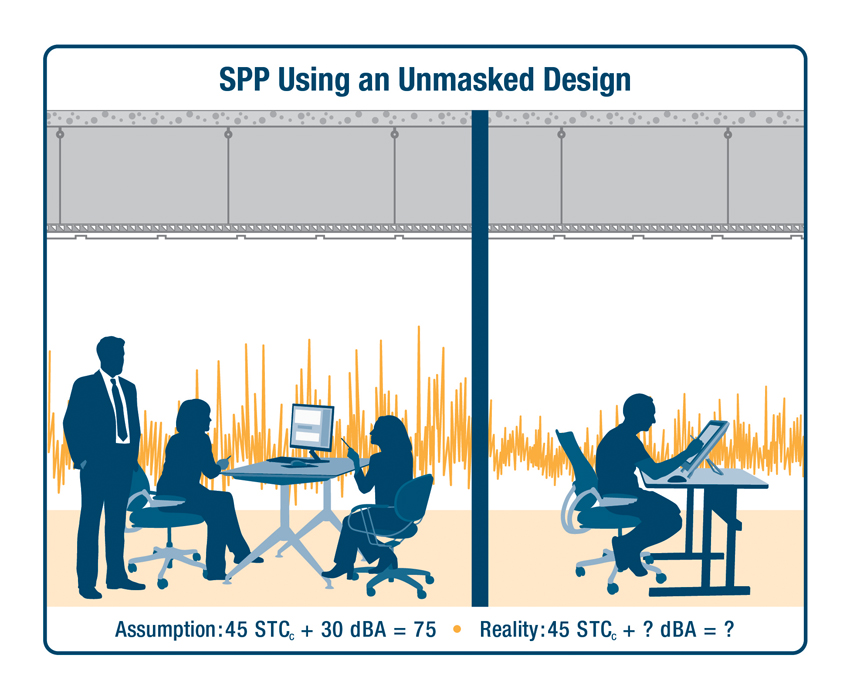
Credit: KR Moeller Associates Ltd.
A design that does not feature sound masking, but rather relies on HVAC to provide an assumed minimum background sound level leads to over-specification of the room’s physical structure, while still leaving its actual acoustic performance up to chance.
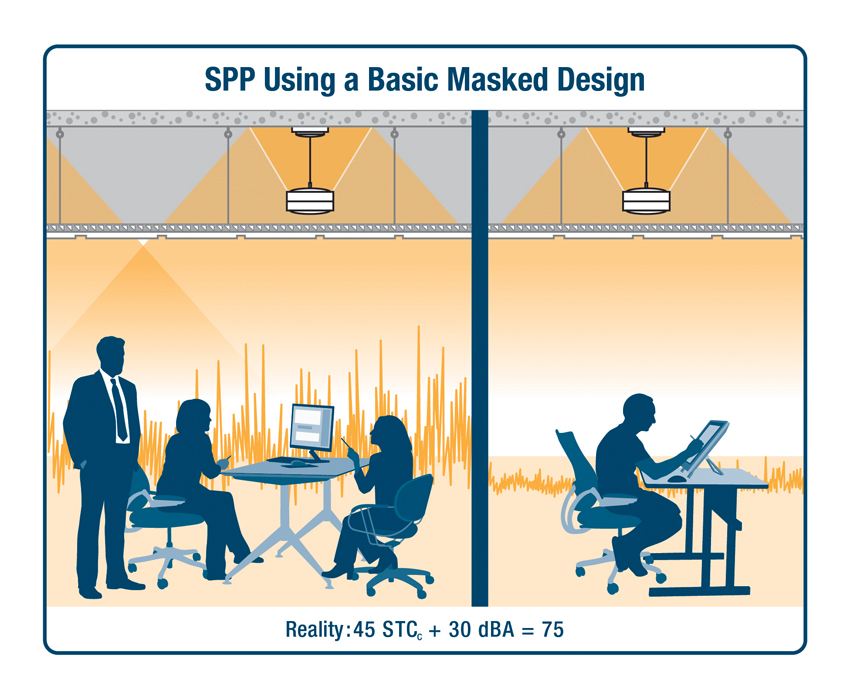
A design that utilizes sound masking to establish a known minimum background sound level—even as low as 30 dBA—as well as a spectrum or ‘curve’ designed for speech privacy, eliminates the variability of HVAC sound, allowing acoustic goals to be more reliably achieved with the stated STCc.
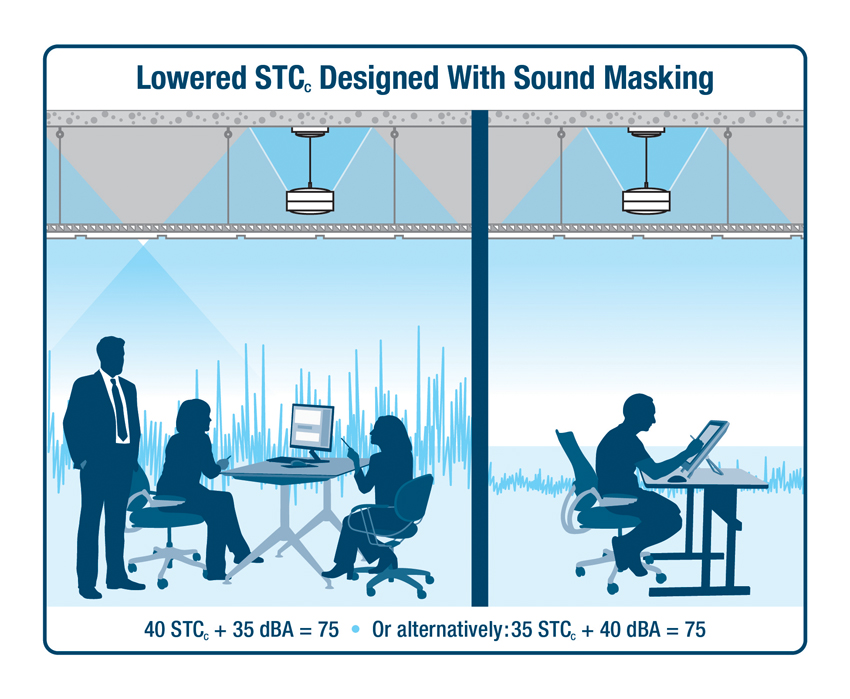
If the background sound level is set to 35 rather than 30 dBA, STCc can be lowered to 40. Alternatively, using a still moderate level of 40 dBA permits STCc as low as 35 while maintaining a Speech Privacy Potential (SPP) of 75. In fact, value can still be derived by the most cautious of specifiers, even if they take only half the increment in background sound as an STCc reduction. For example, with masking at 40 dBA, rather than drop STCc from 45 to 35, an STCc of 40 plus masking at 40 dBA yields an SPP of 80.
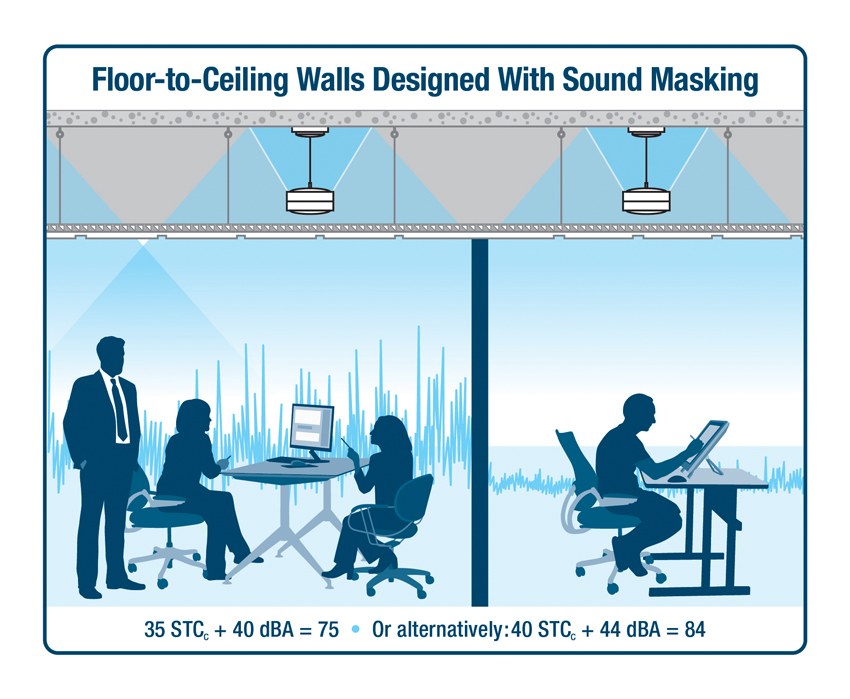
Further value engineering and site flexibility can be achieved by specifying room construction with walls built to the suspended ceiling rather than structure. With STCc at 35 and the masking level reliably set to 40 dBA, SPP is 75. If the STCc is increased to 40 and the masking level is raised to 44 dBA, SPP is 84.
Value Engineering
In the above scenario, the masking sound is set to a level far below that used in traditional applications. The sound is barely identifiable and yet provides the minimum necessary to accurately plan the remaining design elements. However, while the established maximum levels for HVAC can form the basis for the controlled minimum background sound provided by the sound masking system, there are significant opportunities for further value engineering because the predictable overall volume and spectrum allows one to reduce the specifications for the room’s physical shell.
If speech privacy equals STCc + 30 dBA ≥ 75, then, for every 1 dBA increase in the background sound level, it is possible to reduce STCc by one point and achieve the equivalent level of speech privacy. Were the background sound to be increased from 30 dBA to 35 dBA, for instance, construction costs for partition types would start to drop significantly because the STCc could be reduced by five points.
Again, 30 dBA—and, indeed, even 35 dBA—is well below typical masking levels in closed rooms. Usually, they are set to between 40 dBA and 43 dBA in such spaces. Depending on various factors, including occupant comfort, they may be set higher. Therefore, although 30 dBA can be used as a design benchmark, the lowest STCc rating possible to achieve an SPP of 75 is actually determined by the highest comfortable level of continuous minimum background sound.
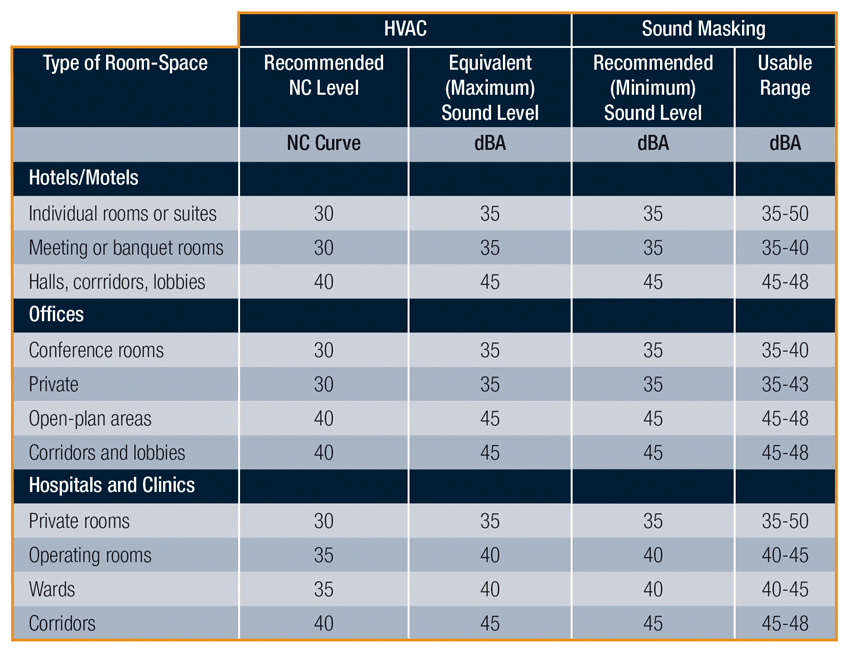
The long-established maximum levels for HVAC systems can form the basis for the continuous minimum background sound produced by the sound masking system. While the background sound can be maintained at a fixed and unwavering level, there is also an opportunity to raise the masking if the partition construction fails to live up to the rated design as a consequence of common deficiencies such as flanking paths.
Additional Savings
Sound masking can also be used in combination with walls (or demountable partitions) built to a suitably Ceiling Attenuation Class (CAC)-rated suspended ceiling in order to provide a cost-effective and more flexible alternative to deck-to-deck construction. Budget wise, sound masking may represent 1 to 2 dollars of cost per square foot of space, but it offsets much more than that in terms of construction above the ceiling. The ability to provide private rooms with walls to the ceiling also increases the ease and cost-effectiveness of relocating them to suit future needs.
For example, the University of Southern California was struggling with how to achieve privacy between medical exam rooms within a healthcare consultation center. With an open plenum, they attempted a number of successive design interventions to improve speech privacy. The addition of plenum barriers—effectively extending the walls to the deck above—did little to address the problem. According to Curtis Williams, Vice President of Capital Construction, it was the addition of masking that “greatly reduced the intelligibility of conversations between the exam rooms, allowing patients and doctors to talk with peace-of-mind knowing that their discussions could not be understood in adjacent rooms.”
In another example, a major American healthcare provider changed its construction standards for medical office buildings away from deck-to-deck construction. After significant testing of mock-up facilities, the company determined they achieved as good or better speech privacy with ceiling-height walls and sound masking. They reported cost savings of hundreds of thousands of dollars for a project of just over 30,000 sf (2787 m2).
There are some cases where one may want to implement both deck-to-deck construction and sound masking; for example, in spaces where raised voices or high-volume media will be used, as well as in areas with high security needs. Also, if the facility features an open ceiling, full height walls are recommended to ensure some degree of inter-zone isolation.
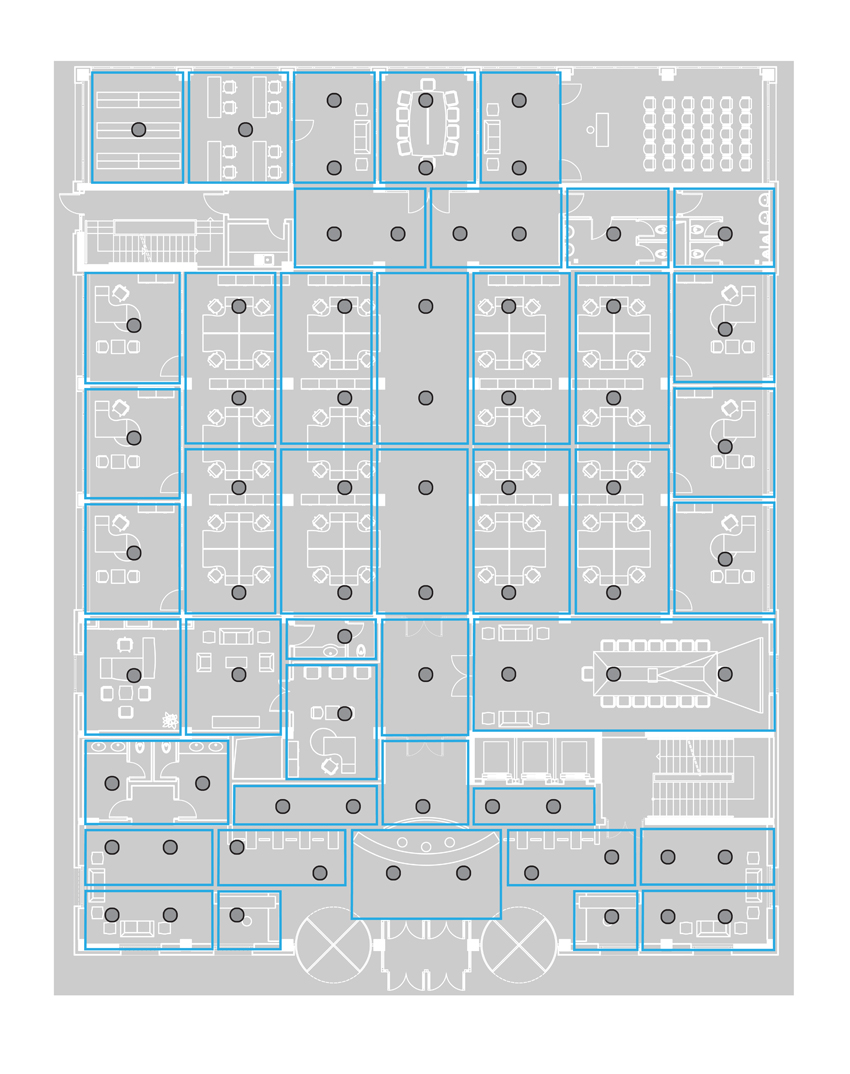
Credit: KR Moeller Associates Ltd.
Providing sound generation, volume, and frequency adjustment in small control zones addresses the tuning challenges posed by large ones. For example, this masking design features 44 zones, allowing the technician to adjust the sound according to local conditions so they can meet the specified curve across the entire treated space.









